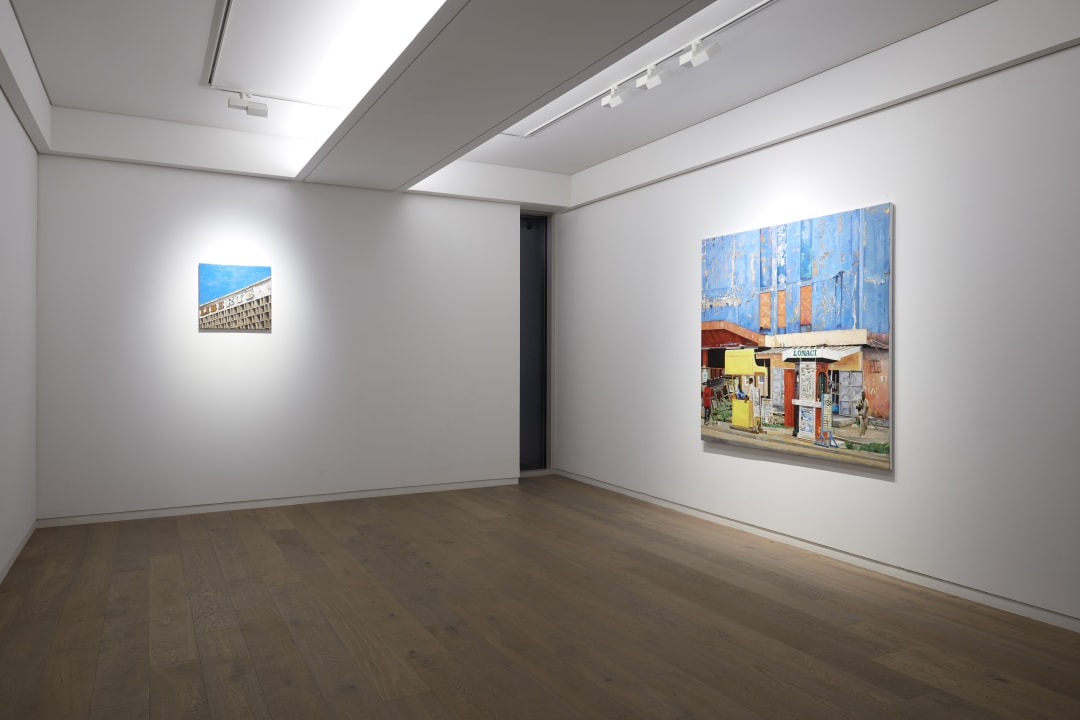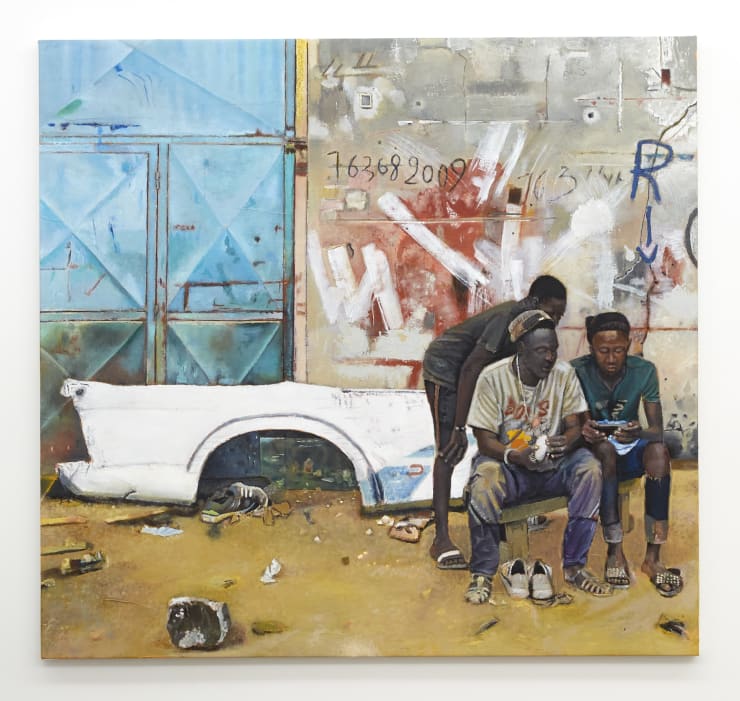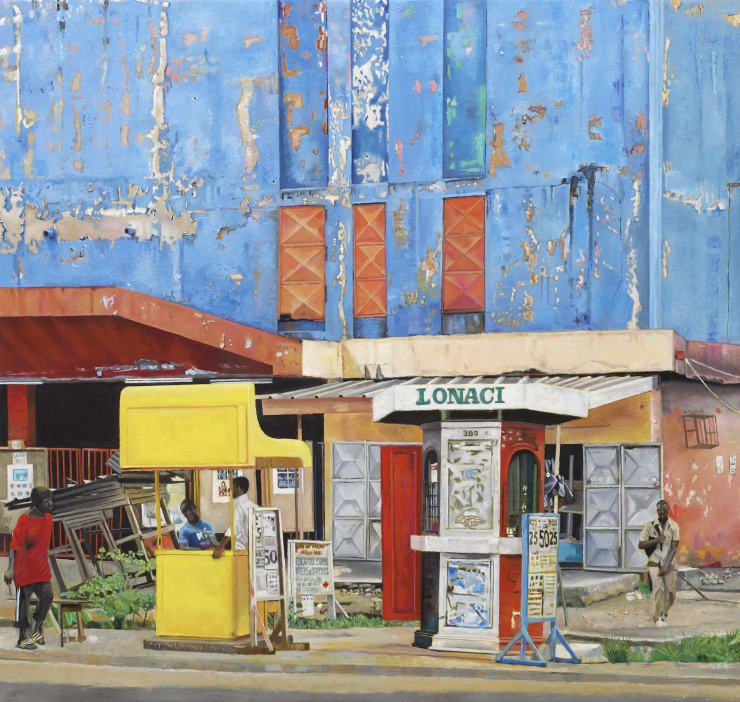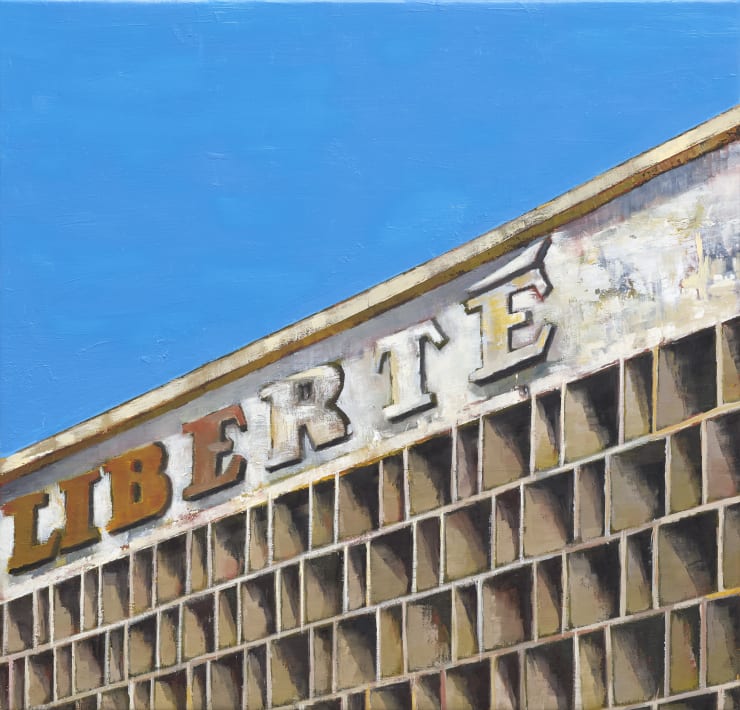Cheikh Ndiaye: Archives of the Sun
Jason Haam is pleased to present Cheikh Ndiaye: Archives of the Sun, Cheikh Ndiaye’s first solo exhibition with the gallery. Featuring new and recent works by the artist, the exhibition provides an insight into the everyday scenes of post-independent West Africa.
Born in Dakar, Senegal, 10 years after its independence from France, Cheikh Ndiaye experienced the aftermath of socio-political unrest and rapid modernisation first-hand. The structural adjustments imposed on Senegal by the International Monetary Fund from the late 1980s led to an expansion of African cities and to a radical growth of informal economies, which constitute one of the main motives of Ndiaye's paintings. Portraying day-to-day scenes, old movie theatres built during the post-independence era, and street vendors’ kiosks in West African metropolises, the artist provides a visual interpretation of the connection between formal and informal architecture and of the occupation of space and people's daily habits.
The title of the exhibition refers to a Senegalese daily ”Le Soleil” (The Sun). Ndiaye— seeing architecture as an archive of social practices—often exploits archival materials depicting social movements in Senegal in his works. At first glance, the modernist movie theatres, which appear in many of his paintings, might seem derelict; yet, a closer examination reveals that they are indeed full of life. While these movie theatres no longer serve the purpose of film projections, they continue to fulfil a vital role within African urban society. Ndiaye's paintings evoke two distinct temporalities: the post-independence enthusiasm of the 1960s and 1970s during which those movie theatres were built and their present transformation. Such temporal shifts serve as a subtle way to question the modern history of West Africa.
The artist's methodology is grounded in a precise observation and reflection on the relationship between architecture, figures, and urban space; he bears witness to people's capacity to inhabit public space. In his new body of work, the artist emphasises the importance of figures within the composition of the painting; this transition from architecture to figures is gradual but evident. In some artworks, buildings start to function as a backdrop rather than as the main subject—the paintings provide an immersive, almost cinematographic experience of architecture. The sky, painted in a single shade of blue characteristic of Ndiaye’s older works, is barely apparent; instead, the canvas captures an intimate view of the subtleties of emotion, embodying a narrative of the lives of people within. In addition to serving as a document of current affairs and of scenes which Ndiaye has personally seen and experienced in his life, his approach pays particular attention to the materiality of the painting: elaborate surfaces of derelict walls or dust-covered folds of tarp are, for him, a way to question the nature and the history of the medium of painting itself. Minute details, expressive use of bright and vibrant colours, and the quality of texture enhance the animated and lively scenes of Ndiaye's paintings.
제이슨함은 2019년 12월 5일부터 1월 28일까지 Cheikh Ndiaye의 개인전 «Cheikh Ndiaye: Archives of the Sun»을 개최한다. 작가 특유의 화법이 담긴 최근작들로 이루어진 이번 전시는 독립 직후 서아프리카의 일상을 들여다볼 수 있는 기회를 마련한다.
프랑스로부터 독립한 지 10년 후, 세네갈의 수도인 Dakar에서 태어난 Ndiaye는 불안한 사회 정치적 기류와 급속한 현대화의 여파를 몸소 경험했다. 1980 년대 후반부터 국제 통화 기금 (IMF) 에 의해 찾아온 세네갈의 내규 조정은 도시의 확장과 급격한 경제 성장으로 이어졌으며, 이러한 환경은 작가의 작품에서 모습을 드러낸다. 작가는 독립 이후에 지어진 오래된 극장과 도시화 된 서아프리카 길가에서 흔히 보이는 노점상 등을 담은 풍경을 통해 개인의 공간과 공공장소의 관계를 시각적으로 재해석한다.
세네갈의 일간지인 “Le Soleil” (The Sun)을 인용한 전시 제목 «Cheikh Ndiaye: Archives of the Sun»은 건축물을 사회적 기록이라고 간주할 정도로 ‘기록’하는 행위를 중요시하는 작가의 작업 성향을 잘 드러낸다. 작가의 작품에 자주 등장하는 근대식 극장의 외관은 언뜻 보기에 버림받은 듯하다. 영화 상영이라는 건물의 본 목적을 잃은 듯하지만, 자세히 살펴보면 활기가 넘치는 공간임을 알 수 있으며 아직도 아프리카의 도시 문화에서 중요한 역할을 수행하고 있다. 이처럼 Ndiaye의 작품은 다양한 공공건물이 지어졌던 시기인 1960-1970년대의 독립 후의 열정을 보여주는 동시에 현재 그 건물의 변화된 모습 그 자체를 보여주기도 한다. 이러한 시대적 변화를 담은 작품은 서아프리카의 현대사에 대한 의문을 제기하고 있다.
작가는 인물, 건물 그리고 도시 간의 관계를 정확하게 관찰하여 작품에 반영한다. 특히 새로운 작업 군을 통해 작품 구성에 있어서 인물의 중요성을 다시 한번 강조한다. 건축물에서 인물로의 주제적 전환은 점진적이지만 확실하다. 이전 작품의 특징이라고 할 수 있는 단일 색의 푸른 하늘은 모습을 감추고, 캔버스 라는 공간을 통해 일상 속에서 생활하는 사람들의 삶과 그 안에서 느껴지는 미묘한 감정의 변화를 나타낸다. 작품을 만드는 과정에서 기록과 보존을 중요시하는 작가는 자신이 직접 보고 겪은 세네갈에서의 경험을 기반으로 끊임없이 작업한다. 작가의 작업 방식은 특히 재료에 대한 그의 관심을 드러낸다. 건물 외벽의 정교한 표면이나 먼지로 덮인 방수포 등을 통해 그림 자체의 본질과 그것의 역사에 대한 질문을 던진다. 밝고 생생한 색상과 질감 표현을 통해 Ndiaye는 생동감 넘치는 Dakar의 다양한 장면을 세밀한 부분까지 빠짐없이 표현한다.
Cheikh Ndiaye는 다카르의 École Nationale des Beaux-arts de Dakar와 리옹의 École Nationale Supérieure des Beaux-Arts에서 수학하였다. 그는 Centre Pompidou (Paris), Fondation Blachère (Apt), Dak’Art Biennale (Dakar) 등 세계 곳곳의 미술 기관에서 전시하였고 La Maréchalerie Centre d'Art Contemporain (Versailles), Musée Africain de Lyon (Lyon)에서 개인전을 열었다. 작가의 작품은 현재 Centre Pompidou (Paris), Centre National des Arts Plastiques (Paris), Fondation Blachère (Apt), FRAC Grand Large (Dunkerque), Frac des Pays de la Loire (Carquefou), KADIST Art Foundation (Paris)에서 소장되었다.







